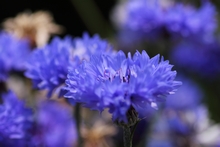Blue Cornflower (the "Kaiser's Flower"): Germany's Floral Emblem with Ties to Royalty
December 12, 2016

Hello again, Naho here. When hot summer days simply don't seem to end, I do truly miss the cool, tranquil blue color.
The national flower of Germany epitomizes the finest blue. In all its elegance, the blue cornflower still has its secrets, as well as some hidden origins.
A Unique Arrow-Spoked Wheel Shape
The floral emblem of Germany is the beautiful cornflower with a refreshing blue color. In Japan, cornflowers are called Yagurumagiku ("Arrow-wheel Flower") because of their unique shape.
For those who are not familiar with the Japanese Yaguruma, or "Arrow-wheel", it is a pair of arrow-spoked wheels used as a decorative windmill on Children's Day (tango no sekku), usually with carp-shaped wind socks flown below it, called the koinobori' ("Carp Streamer"). If you have seen one of those in Japan, you would agree that the petals of a cornflower look just like the arrow-shaped spokes of a Yaguruma.
It wasn't until the Meiji Era (1868-1912) that cornflowers were first introduced to Japan. The lovely flower is relatively easy to grow and thus spread across the country. Today, cornflowers are appreciated by the Japanese as an epitome of the poetic charm of early-summer. Its most common color is blue, although variations of red, white, yellow and pink are also known to have been cultivated.
A Wreath of "Kaiser's Flower" In Praise of Mother's Love
The story of "Kaiser's Flower" can be traced back to the 19th century, when Germany (then Prussia) was in war with France. Napoleon had invaded Berlin, causing Queen Louise of Prussia and the rest of her family to flee the city. Being chased by Napoleon's forces, the Queen and her children had to hide in a cornfield. The princes were restless, too young to understand the war they were living through, so the Queen weaved garlands of blue cornflowers in the field to keep them from crying.
One of those children later became Kaiser Wilhelm I - the first Emperor of Germany. He must have been unable to forget the crown of flowers he had once received from his mother in a cornfield, for he made the blue cornflower a symbol of the Emperor.
Because of its ties to royalty, the blue cornflower is referred to as the "Kaiser's Flower" and beloved by aristocrats as the flower of elegance and nobility. During the same period, German author Novalis also wrote a book related to the symbolism of cornflowers, simply called Blue Flower.
A Flower Adored by Marie Antoinette
Since ancient times, the blue cornflower has been widely appreciated by monarchs and people of high status, not just in Germany, but around the world. It is said that the flower was found as a decoration on the Tomb of Tutankhamun in Egypt. The last Queen of France, Marie Antoinette, also particularly liked silverware with designs of the cornflower.
The exquisite color of blue found specifically in cornflowers also put the English under its charm, hence the name of 'cornflower blue' for the most valuable coloring of Sapphire stones.
Related Services
| << Poinsettia: More than Just a Christmas Ornament - The Surprising Meaning behind Madagascar's Floral Emblem | Movements in Greece: the Focus of the World >> |
To Contact Us Regarding Our Translation Services
For urgent needs, call:
+81-3-5730-6133
